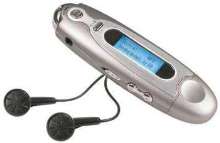I’d forgotten about this one. Not sure if it was published in the Green Guide during my freelance period. Some of the numbers raise the eyebrows today; the prices and the amount of storage. My player was quite small but had a bad design when it came to actually using; a sliding next-prev thing, which you had to push down to ‘hit Enter (select)’. Almost impossible to use without jumping to the next song when trying to select the one you wanted.
For under $300 you can get yourself a good MP3 player. But with so many alternatives, options and acronyms, where do you start? David Sidwell offers some tips on what to look for when purchasing such a device.
 Portable MP3 players pretty much fall into two categories; ones that have no moving parts and ones that use tiny hard drives. The latter can usually store a lot more but tend to be out of our $300 range, so we’ll be looking at the no moving parts ones.
Portable MP3 players pretty much fall into two categories; ones that have no moving parts and ones that use tiny hard drives. The latter can usually store a lot more but tend to be out of our $300 range, so we’ll be looking at the no moving parts ones.
The term ‘no moving parts’ (also sometimes called ‘solid state’) is referring to the memory used to store the MP3 files. This is usually Compact Flash, a clever type of storage that doesn’t “forget” when the power goes off. This is the same type used in a lot of digital cameras too. In contrast the RAM in you PC certainly does “forget” when you power it off – as anyone who has lost power halfway through editing a document can vouch.
The amount of memory in portable MP3 players determines how many songs you can store. A rough rule of thumb is that 1 minute of MP3 takes about 1 MB of data. Hence I’d suggest a minimum of 128 MB, giving you about 2 hours. Another very nice option is the ability to add in extra memory cards; these may be Compact Flash or another type. This means you can – later on – add extra memory.
As an aside, CD music is roughly 10 times as big; so 1 minute of CD music is about 10 MB. The technologies, such as MP3 allow this 10-to-1 compression.
But MP3 is not the only type of compression. Microsoft are pushing their own format which is called WMA. There is also an ‘open’ standard called OGG. MP3 is currently the most common, so aim for that. Other formats would be a bonus, as would be the ability to ‘upgrade’ the player to support these formats.
In most cases the player connects to a PC via a USB cable. This enables you to copy PC MP3 files down to the player, but it can have another real use. The memory in some of the portable players can also be used as a ‘drive’ to store other PC data. Hence if you have to move or copy documents, images or any other files between two PCs, this can be very useful.
In my case, I plug the MP3 Player into the PC, Windows thinks for a few seconds…and then a new drive appears in Explorer. So I have a diskette a:, one hard drive c:, a CD-ROM d: and now a (new) portable drive e: I can read, write and delete files from e: as if it were a normal hard drive.
A good thing to look for is what is called a driver-less MP3 player. This means you do NOT have to install any special software (a driver) to get the player to work with Windows XP etc. Aim for driver-less players, if you plan to use the player with different PCs. Read up carefully as to which versions of Windows it will work with too.
Other nice-to-have options would include:
FM radio tuner
Rechargeable batteries would be a smart move too
MP3 encoding. This is the ability to plug in any sound source and ‘record’ it to MP3 format. If you’ll recall the 10 to 1 compression, you may see the value in this. You should, of course, be very aware of not violating copyright.
Voice recording. An inbuilt – or external – microphone can enable your portable player to become a good quality, digital ‘tape’ recorder…but without tape, of course. I was very impressed with the quality you can get. A recent innovation is using the above MP3 compression for voice recording; a 128 MB player/recorder can record about 6 hours of voice using MP3. You can control the amount of compression; the higher the compression the less space it takes…but at less quality.
Display of MP3 tag data: Early players just showed the file name. The MP3 files can have informational ‘tags’ inside it, listing such things as Artist, Title, Album, Genre, Quality etc.
Here’s a real world example to leave you with. I used the tiny MP3 player (recorder!) to record a message from some family members. I plugged the player into my PC and copied the file from it to the PC. I then changed the MP3 tags to say who was talking, the date and time, the topic etc. Finally I emailed it to a relative overseas. Just a few years ago, this would have seemed like science fiction.
